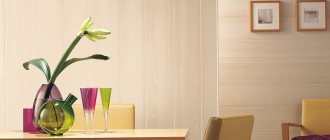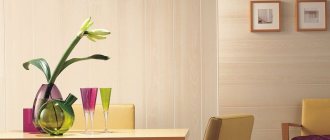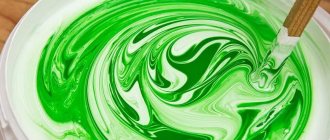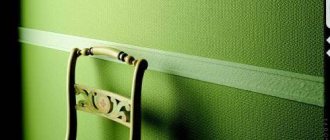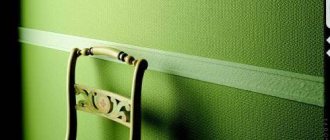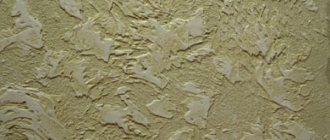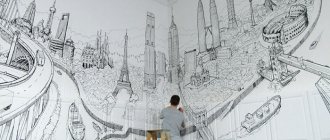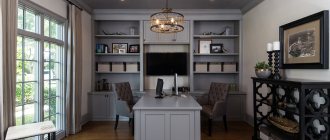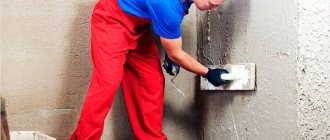When creating an exclusive interior of a room, textured wall painting is an excellent solution. This type of finishing does not require special skills or sophisticated equipment; all work is carried out exclusively with your own hands, which allows you to show your imagination and implement design solutions. For painting, special textural and decorative mixtures or traditional compositions applied in a certain way are used.
Advantages of decorative wall painting
Wall decoration has only one requirement for the covering of the working surface - it must be smooth. In addition, there are a large number of advantages of this type of wall decoration.
Dyes for wall decoration have the following advantages:
- The service life of such coatings is much longer than that of wallpaper, conventional painting and plaster.
- When using such material, no joints will be visible on the wall, and therefore the wall will be solid.
- Huge range of products, many colors and effects.
- If the owner does not like the color, he can repaint the surface without clearing the existing layer.
- Basically, such paints are environmentally friendly, so they can be used for children's rooms, and parents do not need to worry about the health of their children.
- When treating walls with decorative paint, it does not matter what the working surface was previously made of; the material lies equally well on concrete, plaster, and drywall.
Methods of applying textured paint
There are various methods that allow you to implement ideas for decorating a house or apartment.
Double dyeing
This technology includes two methods:
- It is necessary to paint the wall with a light shade of paint; the base layer should have a uniform color. The darker solution is laid second and a relief is immediately formed on the damp surface with a brush. You need to apply a little pressure on the tool so that the base layer appears.
The second layer is applied in a darker shade - The second option is performed in a different order. Textured paint is applied first, the structure is set with a spatula or comb. You need to wait until it dries completely. Next, a more liquid composition of a light or dark shade is applied, which fills all the recesses. Protruding areas are rubbed down with a rag.
A very original design can be applied with a regular comb.
In both cases, at the final stage the surface is treated with a transparent or matte varnish.
Stone effect
This finish allows you to get a textured coating that imitates stone cladding. Scheme of work:
- A thick layer of paint is applied.
- Without waiting for it to dry, the desired pattern is created using a spatula. To do this, jerky strokes are applied with the blade of the tool. They do not have to have precise geometry.
Arranging a stone texture requires some skill - The spatula is cleared of paint. With light movements without pressure, the boundaries of the “stones” are retouched.
- A glaze is prepared, which is used to create transitions and veins. Sometimes such a mixture can be applied to the raw solution to create a vague appearance. But this will require a combination of compounds.
- A layer of varnish or wax is applied on top.
The stone effect can also be achieved using a regular brush and polyethylene.
Each method must be adapted to a specific situation, this will not only allow you to bring your favorite idea to life, but also achieve individuality.
VIDEO: how to apply textured paint on walls with your own hands
Types of decorative paints
First you need to realize that decorating paint is significantly different from ordinary paint. By using this paint, you can achieve unique visual effects. But the craftsmen know how to decorate with ordinary cheap materials and can achieve an exclusive look.
Today we can distinguish the following main options for decorative paints:
- Mother of pearl. Using this type of paint makes the wall look silky. If you look from different angles, the shade of the walls will change.
- Velvet. It has several options for shades of different small fractions. Thanks to this decoration, the walls are visually deep with a slight touch of velvet effect.
- Mosaic. This decoration can be done exclusively using a spray gun. A similar effect is formed due to the spreading of small paint bubbles when they hit the wall surface, forming textured inclusions. This type of paint imitates granite with great accuracy.
In addition to the above options, there are a huge number of decorative paints with different textured inclusions, for example, glaze, enamels, etc. If your budget is very limited, then any of the proposed options will be suitable for decorating walls.
Required Tools
Decorating a living space with your own hands does not require special skills to carry out such work. But in any case, you first need to read the instructions and tips for decorative painting of walls in order to find out how to work and what tools you need to prepare.
For such work, in addition to the decorative paints themselves, you will need the following tools:
- roller;
- several types of spatulas (metal, rubber, serrated);
- sponges;
- hard brushes;
- sandpaper;
- stencil.
Before starting work, you need to decide on the expected effect. Various decorative ideas are made with special tools, so in order not to buy unnecessary equipment, you need to know what kind of design you should get in the end. On the other hand, the price of rollers and brushes is low, especially since they can be used many times.
Options for obtaining the required invoice
To obtain an unusual relief, there are various methods that use a variety of tools and devices.
- Brushes and brushes. This is the simplest option, allowing you to draw stripes that form patterns. Vertical, horizontal, diagonal and wavy directions are considered traditional, but you can show your imagination.
- Comb. Gives a similar result, but differs in more pronounced stripes. However, to obtain complex patterns you need to practice.
- Putty knife. This tool is used to create a rock relief that replicates natural rock. First you should choose the width of the blade: the smaller it is, the more complex the terrain. To apply the pattern, chaotic strokes are made with a spatula, after which the surface is slightly smoothed with a clean tool. A layer of tinting is placed on top.
For textured finishing, a special versatile tool is used - Simple roller. A foam coat leaves behind a fine-grained texture, while a fleece coat leaves behind stripes, the size and depth of which depends on the size of the hairs.
- Curly roller. The pattern is obtained from the drawing on the roller.
- Foam sponge. The walls are literally stamped with this device. The main thing is to avoid clear boundaries.
In general, any suitable materials and tools can be used for the job. Even with your hands you can create an interesting relief.
If desired, with simple tools you can create genuine masterpieces on the walls
Advice! It is recommended to test all created effects on a small area of plywood or cardboard, this will give you an idea of the final result.
Preparing walls for decoration
In the case of finishing walls using decorative paints, for the first time it is necessary to properly treat the working area before painting. With this treatment, your work will be justified, as it will last reliably for many years.
Such preparation should take place in stages:
- First you need to clean the old coating.
- Prime the walls.
- If necessary, repair any damage to the work surface.
- Large uneven areas must be filled with putty.
- Then you need to reapply the primer ball.
After completing all the above steps, the surface is ready for the main work. It should be noted: in order for it to stay on the wall for a long time and reliably, you need to let the plaster and primer dry completely, and then start decorating the working surface.
Types of surface decoration
Due to the fact that natural, environmentally friendly paint costs a lot of money in the store, professional craftsmen and designers have learned to use several types of wall treatments using ordinary paint, which also give a good effect. Today there are several ways to make a universal drawing using ordinary cheap means.
Using stippling
This type of wall painting is characterized by the appearance of an old and shabby surface. This kind of decor is very often used in themed catering establishments.
To create this effect you need:
- Completely cover the work area with regular paint.
- Apply acrylic paint with a second ball for contrast.
- Then you need to apply a colored glaze that will be combined with the overall picture, and after covering the entire working area with glaze, you need to apply point touches on the wall with the same brush for the effect of an old wall.
- You need to work with a brush in a chaotic manner, then the surface will be more realistic.
This method has one big disadvantage - all irregularities are very clearly visible in a lit room.
Skin effect
This effect is often used in private offices. But it can also be used in residential areas. Before decorating, the surface must also be treated according to the above scheme.
To create the illusion of skin:
- First, cover the walls with latex paint of the selected color.
- We make a tassel from suede.
- Mix glaze and latex paint, just a little darker than the main color of the wall.
- After this, this mixture should be applied to a small part of the wall, and a suede brush should be moistened in water and squeezed out. After this, use smooth touches to smear the mixture applied to the surface and partially remove it.
- We soak the resulting lines with a piece of wet suede to create a natural leather effect.
Venetian plaster effect
This type of decor is rightfully considered one of the most beautiful today. This color can be used both in offices and in residential buildings and corridors. She will look appropriate everywhere.
To recreate the effect of Venetian plaster using regular paint you need:
- Pour the selected latex paint into a large container. On one side of this container you need to pour pigment for paint and stir gently until a mixture is formed that is darker in color than in the other half of the same container.
- Then you need to take a little paint, the lighter one, on a spatula and apply it to the work area like regular plaster.
- The next step is to apply darker paint to a piece of the already coated wall with a spatula.
- When both light and dark spots appear on the wall, you need to start smearing them left and right, up and down to spread them evenly across the work surface, creating a natural look.
At the finish, you need to wipe the dry working area with sandpaper, and then cover the paint with a special wax mixture.
Wrinkled skin illusion
This effect can also be used in many types of premises, but it is more suitable for cafes, restaurants, etc. Creating such a coating does not require special skills or effort. The only difficulty is that the process itself is very long and requires a lot of patience.
For a wrinkled skin effect:
- Take a small piece of paper; you need to smear a piece of the wall according to its size.
- A sheet of paper needs to be crumpled and applied to the work surface.
- Smooth the sheet over the wall, thereby creating a wrinkled effect.
This way you need to treat the entire wall.
Using a cloth roller
In order to create a decorative surface, you can use not only tools that can be bought in the store, but also available equipment. Even a homemade rag roller will do, with which you can create a very beautiful effect. This type of decor is very popular, especially in children's rooms. The advantage of this type of finishing is that you don’t have to spend too long on the initial treatment of the walls, since this style of painting hides all the imperfections and damage.
To do this you need:
- First apply the first coat of paint, then wait for it to dry completely.
- Then we add another shade of the main color already used, but a little darker.
- The rag needs to be smeared with the resulting paint, twisted and wound onto a roller.
- You need to paint over the entire plane of the working surface in different directions to obtain a characteristic pattern.
How to choose wall paint
Experts believe that it is better to use dispersion (emulsion) paints indoors. They are good because they have increased adhesion to most substrates - they can be applied to concrete, drywall, various types of plaster, and brick.
Moreover, such mixtures can be used in the home, since they are characterized by a high degree of environmental safety. The materials form a smooth surface, which, if necessary, can be easily cleaned with water and the addition of any detergent.
It is necessary to take into account such properties of paints as the formation of a coating that is resistant to abrasion and good vapor permeability - thanks to them, painted bases are not afraid of fungus and mold. In addition, emulsion mixtures are convenient to use. They have a thick consistency, so they do not drip during processing and do not leave streaks; you can handle the job yourself.
This is a large category of paints, which includes compositions based on different binders - latex, vinyl, acrylic.
The mixture should be selected taking into account where it will be used:
- In the living room or bedroom, it is better to paint the floors with matte acrylic solutions. They hide minor surface irregularities, the matte texture looks aristocratic. It is recommended to treat a room intended for night rest with acrylic compounds with increased vapor permeability in order to create a good microclimate.
- It is also recommended to use acrylic options in the children's room, since they are characterized by zero emissions, i.e. they do not contain harmful substances.
- For the bathroom and kitchen, compositions with increased moisture resistance are needed. Here it is better to use latex products, and those that include antifungal additives. For the kitchen, latex types are good because grease stains are quickly washed off from them.
- For the hallway, it is recommended to choose acrylic-latex compositions, since they are considered more resistant to abrasion. If wall panels are used, they can be painted with alkyd materials, provided they are thoroughly ventilated.
The color scheme and degree of gloss depend on the overall concept. Color solutions should support the design idea. But a lot also depends on the characteristics of the room, its lighting, and geometry. For example, walls painted in light colors will make the room visually more spacious.
Separately, another category of paints is mentioned - textured. Their difference lies in their thicker consistency and the presence of various impurities, which allow them to obtain a beautiful relief after drying. They give the same effect as decorative plaster, i.e. they create attractive irregularities on the surface. Interesting design solutions are possible here, and they are accessible even to those who have no experience working with such compositions.
Classification of paints by composition
Wall decor can be made in a variety of ways using special dyes. There are many color tones and shades. But different decorative paints have their own properties. Depending on the properties of each paint, they are mainly distinguished:
- Acrylic. Mainly used for painting apartments, but can also be used for other premises. Their popularity is due to their excellent price-quality ratio. They are also used because they are fireproof, strong and durable, are not afraid of temperature changes, dry quickly, have excellent adhesion to the coating, and a large range and variety of paints.
- Latex. Mainly used in rooms with high humidity. When applying such paints, a protective layer is created that does not allow moisture to pass through. The main advantages of such paints are the absence of a specific odor, fire resistance, and moisture resistance. They can be diluted with ordinary water without losing their properties, the paints dry quickly, they are durable and environmentally friendly. In addition to the above positive qualities, there are also negative ones. Such paints do not have bright colors and shades in their arsenal. Also, under a layer of paint there are simply excellent conditions for the proliferation of organisms and bacteria. Before starting work, it is necessary to properly treat the wall with a primer.
- Water-based. They cannot create any special decor or beauty. But due to their cheapness, they are very popular, since they cope well with the task of painting the surface. The advantages of this working material are one of the lowest prices on the market, economical use, since the paint is enough for a large area, and no harm to health. The disadvantage is the quality, since it is very quickly washed off from the covering of the working area, and the need for a certain temperature when painting the working surface.
- Alkyd and oil. Such materials are very often used in many rooms. But the price of paint is rather high, which is a significant disadvantage, as is the strong specific smell and high consumption of material. The positive aspects of this type are contrasting and rich colors, a durable and thick layer, and a long service life.
Choosing paint
General advantages and disadvantages are typical for all types of paints, but they are distinguished by several main types, and each has its own features and characteristics. Paints are divided into groups according to the film-forming base.
Alkyd paints
Alkyd paints have good moisture resistance and resistance to UV rays. This group includes oil and enamel paints. Oil paints are inexpensive, but they dry for a very long time, while emitting an unpleasant toxic odor, and they can turn yellow over time, so it is better not to use them for painting interior surfaces. In addition, it does not allow air to pass through well, so after some time cracks are visible on the surface.
Enamel paints are already performing much better: they dry quickly, do not emit odor, are suitable for a wide range of surfaces, have anti-corrosion properties, are light and water resistant.
Emulsion paints
In water-based paints, the coloring pigments are dissolved in water, and when it dries, an even, monochromatic coating remains on the wall. They are easy to use, environmentally friendly, odorless, washable, and after applying the paint, it is easy to wash the tool and reuse it. They can be applied to almost any surface, but it is better to prime metal elements first, and it is better not to use water-based paints over glossy and adhesive paints - but all other types of paints fit well on its base.
Among acrylic paints, the following types are distinguished:
- water-based paints breathe well, do not peel off, are striking in their variety of colors, and there may also be options that give a three-dimensional structure. However, they cannot be used in rooms with high humidity, and they may wear out a little due to frequent washing. However, this is one of the most popular and used paints for interior work;
- water-dispersion ones also conduct air and steam well, but they can be washed many times, they do not peel off and show good results in use. But they, as a rule, are presented only in white, and their application at temperatures below +5 degrees is difficult;
- acrylic paints are very durable, elastic, have high mechanical resistance, as well as high gas impermeability. The latter property makes it possible to paint reinforced concrete to protect it from corrosion, but acrylic paint is not suitable for fresh plaster, since carbon dioxide is released during hardening, and it is gas-tight. This paint can be tinted, it does not fade in the sun over time, can hide even small cracks, and has vapor-permeable and water-repellent properties. True, they are a little expensive, since acrylic resins are used as a base;
- latex paints show excellent water resistance, so you can wash them as much as you want without losing the quality of the coating. It may fade slightly when exposed to ultraviolet rays. The paint is excellent for all types of surfaces, dries quickly, but among emulsion paints it is the most expensive;
- polyvinyl acetate paints are a cheaper option, do not fade in the sun, are environmentally friendly, resistant to oils and fats, but are washed off when exposed to water;
- silicone paints, after drying, form a layer of paint that is resistant to water, but perfectly permeable to steam and air, they can hide cracks up to 2 mm, and are suitable for any mineral surfaces, they can also be applied over some paints, but the rather high price does not favor them wide distribution.
Adhesive paints
Adhesive paints consist of water-based organic polymers and have properties similar to emulsion paints, but are more afraid of water, so they are used only in areas where its influence is limited. Thus, in damp and poorly ventilated areas, such paint can become a habitat for microbes and bacteria.
And depending on what substances are used in the production of paint, there are several types:
- dextrated - with inert glue, well suited for interior work, but not in particularly wet areas;
- casein - the most durable and aesthetically pleasing of those presented, suitable for use on mineral substrates such as brick, concrete and plaster;
- Adhesive paints have a huge selection of colors and are environmentally friendly.
Silicate paints
These are mineral paints that contain liquid glass, and since the paint has an alkaline reaction, you need to be extremely careful when applying it. This composition imposes restrictions on application: glass, metal, stone and ceramic surfaces are afraid of such an environment, so this paint is not suitable for them. It cannot be used over alkyd acrylic paints; due to its composition, the choice of colors is also limited. But all this is compensated by advantages: the paint has excellent vapor and air permeability, can be washed, and is resistant to temperature changes.
General recommendations for application
Many people are interested in the question of how to renovate a room with their own hands without the help of professionals, but not everyone knows how to work correctly.
Basic recommendations from experts:
- It is necessary to prime the surface well before work.
- It is imperative to cover the floors with a protective film.
- First smear the working area horizontally, and then vertically.
These tips will help you avoid repair failures and eliminate the need to redo the job. Using progressive wall painting techniques, you can get a truly unique room design, as well as realize all your creative fantasies.
